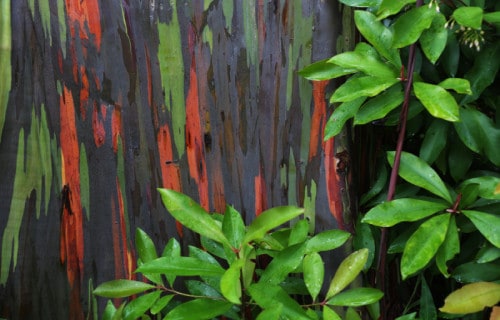
5 Incredibly Wonderful Trees
Like the stunning sentinels of Nature, trees stand guard over the various landscapes they appear on. They provide a refuge for many species of insects and various animals alike. They also provide food, both for the wild animals of the world and we humans as well. In addition, they are a leading provider of clean air for all living things to breathe. But not all trees are created equal. Here are our choices for 5 Incredibly Wonderful Trees. We hope that you enjoy and appreciate them as much as we do.
Monkey Puzzle Tree
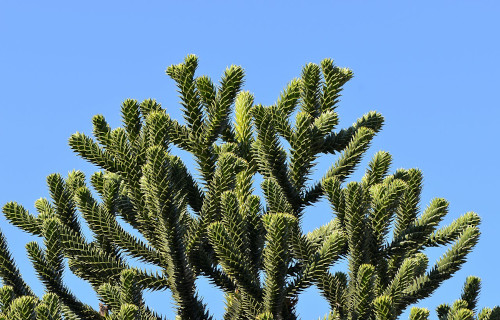
CCL: https://bit.ly/3l5i1hx
Monkey Puzzle Tree Facts
- Monkey Puzzle Tree serves as the colloquial name for the Araucaria araucana. This plant species remains an ancient one that often gets called a living fossil.
- The rather unique name also originated in 1850 when someone observed that it would puzzle a monkey to climb it. How that person came up with that description is just incredible.
- But this tree remains very rare in the wild. Though it develops as a hardy and resilient variety, its numbers seem to be dwindling rapidly in nature. It now forms a popular garden species in some regions.
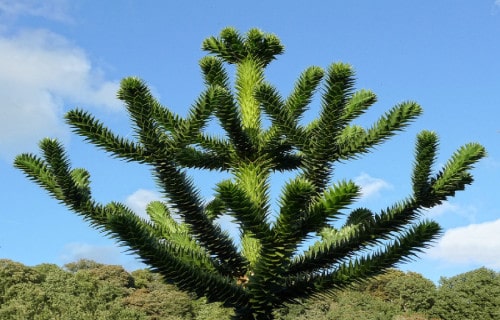
Monkey Puzzle Tree Physical Characteristics
The remarkable Monkey Puzzle Tree tree represents a dioecious species. The cones of individual trees typically all form either male or female though occasional exceptions occur.
This evergreen attains a height of as much as 130 ft (40 m), and the trunks reach 7 ft (2.14 m) in diameter.
The wind serves as the primary pollinator. The seed cones of the Monkey Puzzle Tree reach about 8 in (20 cm) in diameter and disintegrate upon maturity. The seeds released reach roughly 1.6 in (4 cm) in length.
The leaves of the Monkey Puzzle Tree also grow thick and tough, and also roughly triangular in shape.
This species evolved as extremely long-lived. Some individuals also measure more than 1,000 years old.
Kingdom: Plantae
Phylum: Pinophyta
Class: Pinopsida
Order: Pinales
Family: Araucariaceae
Genus: Auracaria
Species: A. auracana

Monkey Puzzle Tree Habitat and Uses
The Monkey Puzzle Tree evolved as endemic only to the lower slopes of the Andes Mountains in portions of Argentina and Chile, in South America. Within this region, the tree generally grows at altitudes above 3,300 ft (1,000 m).
Though rather tolerant of diverse soil types in cultivation, the Monkey Puzzle Tree occurs naturally only in regions of slightly acidic volcanic soil with excellent drainage.
Its rather unique appearance also makes it popular in gardens. Besides, the seeds remain edible and highly nutritious for which they get widely harvested in Chile.
Due to both its scarcity, and sacred status to members of the local indigenous peoples, the Mapuche Native Americans, the tree now holds the status of a protected species in the wild.
The cause of its decline in the wild comes from a loss of habitat due to human encroachment. No surprise there. Therefore, the IUCN lists the species as Endangered.
Chilean Firebush
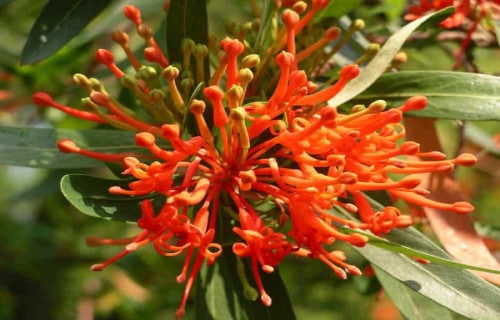
Chilean Firebush Facts
- The fascinating Chilean Firebush possesses a rather remarkable and unique attribute that sets it apart from virtually all other known plants.
- This unusual genus has the ability to access various nutrients in the soil that normally remain inaccessible to plants. This appears to be especially true of phosphorus.
- The members of this genus accomplish this through an adaptation of the root system. While in the seedling stage, it generates an extremely dense type of root mass known as cluster roots.
- These release various acidic substances into the soil.
- These substances transform normally unusable elements into forms that the plant uses for nourishment. This has the side effect of providing extra nutrients to other plants via falling leaves.
- For this reason, the Chilean Firebush also ranks a keystone species within its habitat.
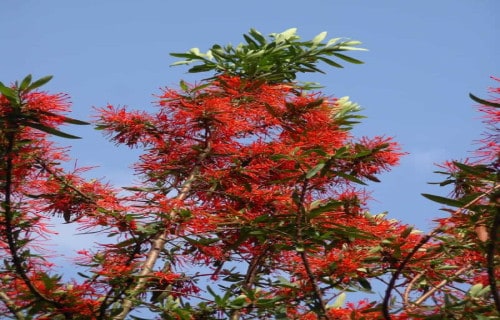
Chilean Firebush Physical Characteristics
The seemingly aptly-named Chilean Firebush may appear as either a tree or an extremely large shrub, depending on environmental factors.
The tree often attains heights of as much as 50 ft (15 m). However, most rarely reach that height. An average trunk diameter measures roughly 20 in (50 cm), and the bark predominantly has a dark gray hue, with lighter spots.
The wood of the Chilean Firebush actually evolved a light pink in color and stays quite soft but very durable. The blooms appear in large clusters and typically display a deep red color.
The plant also appears to be predominantly pollinated by a combination of insects and hummingbirds.
Kingdom: Plantae
Phylum: Angiosperms
Class: Eudicots
Order: Proteales
Family: Proteaceae
Genus: Embothrium

Chilean Firebush Distribution, Habitat, and Ecology
The Chilean Firebush represents a small species of evergreen tree. It is endemic to the temperate forests of Argentina and Chile, in South America.
The various members of the genus appear in scattered populations as far south as Tierra del Fuego.
Within its endemic habitat range, this rather impressive genus of plants inhabits a variety of habitats. It appears from sea level to altitudes of as much as 6,562 ft (2,000 m).
While it typically prefers regions with a high moisture level, it has also proven itself to be rather adaptable to moderately dry climates.
Although in cultivation it most commonly appears as an ornamental plant, it also serves as a source of timber in some parts of its native range.
Unlike the majority of flowering trees, the pollination of members of this rather impressive genus is primarily achieved through the activities of various types of birds.
Rainbow Eucalyptus

Rainbow Eucalyptus Facts
- The living kaleidoscope known as the absolutely beautiful Rainbow Eucalyptus forms the only species of eucalyptus tree endemic to the Northern Hemisphere.
- It can also now be found growing in numerous other parts of the world. This has come about due to its (eminently understandable) popularity as an ornamental tree.
- Yet beauty alone does not distinguish this plant. This colorful tree also happens to be one of the most rapidly growing of all those known. Some specimens have been known to grow incredibly fast.
- In fact, in parts of its endemic range, this tree also gets used in the manufacturing of paper.
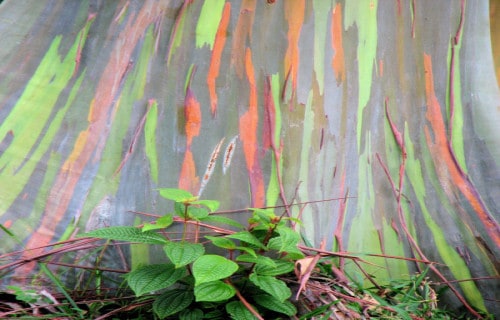
Rainbow Eucalyptus Physical Description
Arguably the most distinctive feature of the Rainbow Eucalyptus remains the gorgeous, multi-hued bark.
This effect happens in stages. First, a vertical shedding of the bark occurs. Second, this process also occurs in random patches. The new bark actually appears rather green at first.
The colors change through the spectrum as the bark remains exposed to the air. Consequently, the colors vary from patch to patch.
Also, this species grows rather tall, to say the least. It achieves an average height of 200 ft (60 m).
The trunks grow relatively thick in structure. These can actually grow to a diameter of as much as 8 ft (2.4 m).
The leaves often reach 8 in (20 cm) in length and grow lance-shaped.
The monoecious flowers develop small, and bright white in color.
Next, when mature, the fruit remains tiny, and a dark brown in color.
Kingdom: Plantae
Order: Myrtales
Family: Myrtaceae
Genus: Eucalyptus
Species: E. deglupta
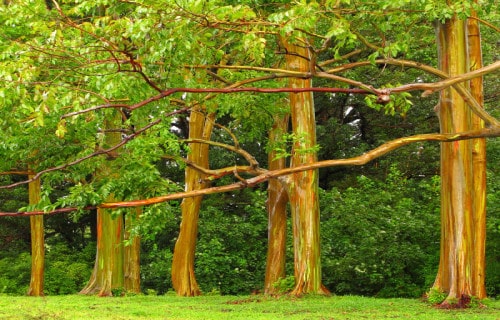
CCL: http://bit.ly/2JszWtI
Rainbow Eucalyptus Habitat and Ecology
It ranks as especially relevant that there continues to be considerable debate over the true endemic range of the Rainbow Eucalyptus.
This occurs because its range currently remains considered to span the islands of New Britain, New Guinea, Sulawesi, Seram, and Mindanao. There seems to be some evidence that the species originated on Mindanao and then spread to the others.
On each of these islands, the tree remains native to regions of tropical rainforest. The copious rainfall in such forests serves as vital to its growth.
Outside of this endemic environment, the colors of the bark stay far less pronounced. Ultimately, in introduced regions, it grows fairly well in subtropical climates, but not those cooler.
The typical lifespan of this species also seems to be nearly 150 years.
Bristlecone Pine
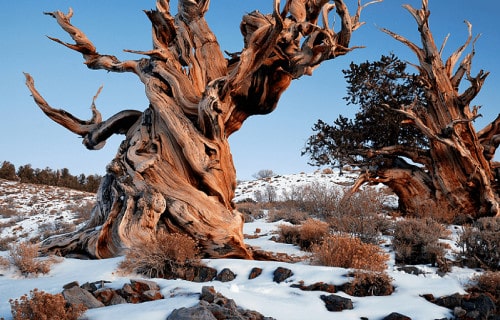
Bristlecone Pine Facts
- The Bristlecone Pine ranks as the oldest known non-clonal living species on Earth.
- The tree grows slowly, due to the dry soil, cold conditions, high winds, and short growing seasons.
- It also never attains a very great height. Even the needles on the pines may remain there for as long as forty years.
- Genetically related and visually similar pines exist, and it is often rather difficult to distinguish one species from the other.
- Therefore, an exact tally of the Bristlecone’s numbers is not available.
- Three recognized varieties exist, with all three being extremely long-lived.
- The IUCN currently lists all three species of the Bristlecone Pine as Near Threatened.
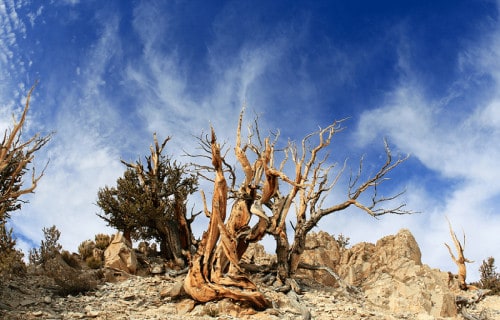
CCL: https://bit.ly/1ryPA8o
Bristlecone Pine Physical Description
The trunks of the amazing Bristlecone Pine develop extremely gnarled shapes and patterns, making it a rather distinctive looking tree.
The tree also remains relatively small, never achieving a height greater than 60 ft (18.3 m). In fact, most individuals remain considerably shorter than that.
Its root system grows extremely branched and typically remains quite shallow. Typically, only a few larger roots provide the necessary stability.
The wood develops extremely dense and rather resinous. This has the benefit of providing it with resistance to insect pests, aiding in its longevity.
Kingdom: Plantae
Phylum: Pinophyta
Class: Pinopsida
Order: Pinales
Family: Pinaceae
Genus: Pinus
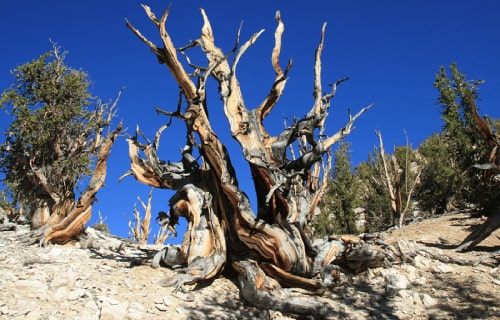
CCL: https://bit.ly/1p2b8Ke
Bristlecone Pine Distribution, Habitat, and Ecology
The astonishing Bristlecone Pine lives only on remote, dry mountaintops in six states in the United States, in North America.
The species also generally occurs at or above altitudes of 10,000 ft.
All known specimens average 1000 years old, and the oldest one’s name is Methuselah, currently 4,789 years old. The tree also remains popular for the distinctive whorls and other unusual patterns it often develops.
Given its rather great density, dead trees can remain standing for centuries. Most surviving individual trees can be found in National Parks and are thus protected by law.
It grows at high altitudes, ranging between 5,600 and 11,200 ft (1,700 and 3,400 m) in elevation.
It also grows in soil that contains high amounts of sandstone, limestone, calcium, and magnesium.
Bosnian Pine
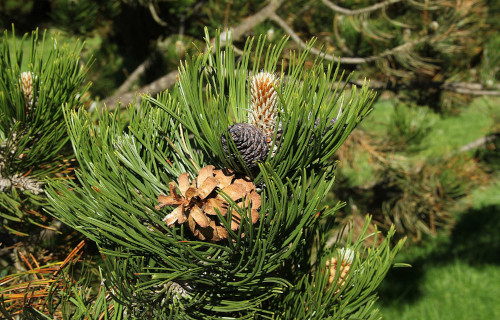
Bosnian Pine Facts
- Likely the best known individual specimen of the rather astounding Bosnian Pine resides in Bulgaria. This specimen also bears the rather interesting name of Baikushev’s Pine.
- This particular individual tree stands roughly 79 ft (24 m) tall and experts also estimate its age to be least 1,300 years, perhaps even older than that.
- The species was first officially described by botanist Hermann Christ, in 1863, based on samples collected from the heights of Mount Olympus.
- Some of its rather unique physical characteristics have led to its becoming quite popular as an ornamental tree, common in parks.
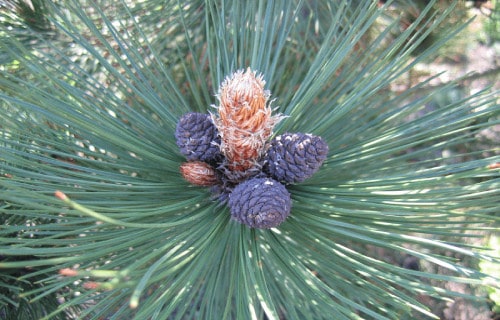
Bosnian Pine Physical Description
The rather remarkable Bosnian Pine represents a plant species known for the distinctiveness of its seed cones. When these first appear, they show a rather bright purplish blue in color.
These cones also reach an average length of roughly 4 in (10 cm).
Yet, as these mature, they darken to the rather more common brown shade. At full growth, the bark of the tree becomes an ash gray in color.
Individuals also typically attain a maximum height of roughly 115 ft (35 m). However, smaller sizes remain the more common.
Kingdom: Plantae
Phylum: Pino[hyta
Class: Pinopsida
Order: Pinales
Family: Pinaceae
Genus: Pinus
Species: P. heldreichii
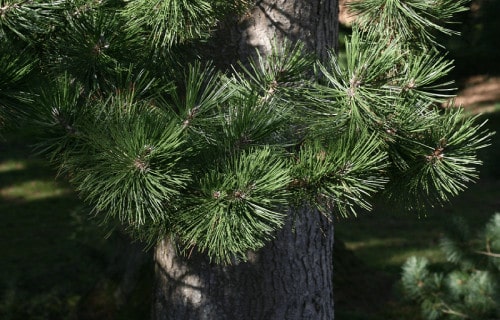
CCL: https://bit.ly/1ryPA8o
Bosnian Pine Distribution, Habitat, and Ecology
The Bosnian Pine evolved as a species of pine endemic to southern Italy and mountainous regions of the Balkans, in Europe. It also only occurs in seven countries. These countries include Albania, Bosnia, Bulgaria, Greece, Italy, Macedonia, and Serbia.
The fascinating tree typically grows at altitudes ranging from between 4,900-8,200 ft (1,500-2,500 m). This variety of evergreen also averages 6.5 ft (2 m) in trunk diameter.
The species remains known for its great hardiness and resistance to extreme weather conditions. Due to this, it grows well in either partial or full sunlight. Its rate of growth stays slow but quite steady.
Fortunately, the tree appears to be able to adapt to extreme environmental conditions. For the moment, the IUCN lists the species as Vulnerable.
Like many species, its greatest threats appear to be climate change and habitat loss.

5 Incredibly Wonderful Trees
And here you have had our choices of 5 Incredibly Wonderful Trees. Obviously, there remain countless hundreds of other species of tree that could easily qualify for this list. Let us know your choices for other varieties of trees that you find unique, or even just interesting or lovely. The wonder and majesty of Nature know no bounds. And remember…trees literally help our planet breathe.
Check out our other articles on Kauri Tree, African Blackwood, Coast Coral Tree, Jellyfish Tree









Leave a Reply